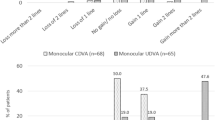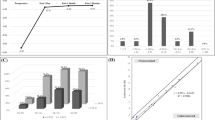Abstract
Purpose
To assess the visual outcomes and ocular safety when implanting diffractive trifocal intraocular lenses in a population of high myopic eyes.
Methods
This is a retrospective cumulative clinical study. Two hundred five myopic eyes consecutively operated in the hospitals of Clínica Baviera, Spain, were included. All eyes presented an axial length equal or greater than 26 mm and were treated and examined following the same methodology for at least 2 years. Refractive and visual outcomes and also intraoperative or postoperative complications were tabulated for later analysis. Furthermore, a subjective questionnaire was completed by all patients at the end of the follow-up period.
Results
The percentage of eyes that lost two or more lines of corrected distance visual acuity (CDVA) was 5.9%, 11.5% and 10.7% 3, 12 and 48 months after surgeries respectively. However, 33% of eyes gained two or more lines of CDVA 2 years after implantation. Excimer laser correction of residual refractive error was performed after implants in 29.75% of eyes. Uncorrected distance visual acuities (UDVAs) were significantly better 1 year (0.10 ± 0.3 logMAR) and 2 years after the surgeries (0.10 ± 0.14 logMAR) compared with those estimated 3 months postoperatively (0.14 ± 0.15 logMAR; Kruskal–Wallis; p < 0.001). Mean near and intermediate uncorrected visual acuities remained stable from the first to the last postoperative visit (Kruskal–Wallis; p > 0.05 for all comparisons). Of the eyes, 27.31% were diagnosed and treated with yttrium aluminum garnet (YAG) laser after being diagnosed as having posterior capsular opacification. Retinal detachment (RD) was diagnosed in six eyes (2.92%).
Conclusions
Diffractive trifocal IOLs have good efficacy and predictability in high myopic eyes. Retinal concerns should lead the surgeons to explore other alternatives for refractive surgery in young patients without cataracts.


Similar content being viewed by others
References
Bellucci R (2005) Multifocal intraocular lenses. Curr Opin Ophthalmol 16(1):33–37
Alfonso JF, Fernandez-Vega L, Orti S, Ferrer-Blasco T, Montes-Mico R (2010) Differences in visual performance of AcrySof ReSTOR IOL in high and low myopic eyes. Eur J Ophthalmol 20(2):333–339
Wang Q, Zhao G, Wang Q, Jia W (2012) Visual quality after AcrySof IQ ReSTOR intraocular lens implantation in eyes with high myopia. Eur J Ophthalmol 22(2):168–174. https://doi.org/10.5301/EJO.2011.8357
Martiano D, Cochener B (2014) [Multifocal IOLs in the high myope, 6-year follow-up]. J Fr Ophtalmol 37(5):393–399. https://doi.org/10.1016/j.jfo.2013.08.009
Ogawa T, Shiba T, Tsuneoka H (2015) Usefulness of implantation of diffractive multifocal intraocular lens in eyes with long axial lengths. J Ophthalmol 2015:956046. https://doi.org/10.1155/2015/956046
Chang JS, Chan VK, Ng JC, Law AK (2016) Visual performance after bilateral implantation of a four-haptic diffractive toric multifocal intraocular lens in high myopes. J Ophthalmol 2016:5320105. https://doi.org/10.1155/2016/5320105
Steinwender G, Schwarz L, Bohm M, Slavik-Lencova A, Hemkeppler E, Shajari M, Kohnen T (2018) Visual results after implantation of a trifocal intraocular lens in high myopes. J Cataract Refract Surg 44(6):680–685. https://doi.org/10.1016/j.jcrs.2018.04.037
Law EM, Aggarwal RK, Kasaby H (2014) Clinical outcomes with a new trifocal intraocular lens. Eur J Ophthalmol 24(4):501–508. https://doi.org/10.5301/ejo.5000407
Gatinel D, Pagnoulle C, Houbrechts Y, Gobin L (2011) Design and qualification of a diffractive trifocal optical profile for intraocular lenses. J Cataract Refract Surg 37(11):2060–2067. https://doi.org/10.1016/j.jcrs.2011.05.047
Alio JL (2011) Lens surgery (cataract and refractive lens exchange) and retinal detachment risk in myopes: still an issue? Br J Ophthalmol 95(3):301–303. https://doi.org/10.1136/bjo.2010.186429
Rosen E (2006) Risk management for rhegmatogenous retinal detachment following refractive lens exchange and phakic IOL implantation in myopic eyes. J Cataract Refract Surg 32(5):697–701. https://doi.org/10.1016/j.jcrs.2006.03.012
Rosen ES (2008) Risk management in refractive lens exchange. J Cataract Refract Surg 34(10):1613–1614. https://doi.org/10.1016/j.jcrs.2008.08.001
Dupps WJ Jr, Kohnen T, Mamalis N, Rosen ES, Koch DD, Obstbaum SA, Waring GO 3rd, Reinstein DZ, Stulting RD (2011) Standardized graphs and terms for refractive surgery results. J Cataract Refract Surg 37(1):1–3. https://doi.org/10.1016/j.jcrs.2010.11.010
Stulting RD, Dupps WJ Jr, Kohnen T, Mamalis N, Rosen ES, Koch DD, Obstbaum SA, Waring GO 3rd, Reinstein DZ (2011) Standardized graphs and terms for refractive surgery results. Cornea 30(8):945–947. https://doi.org/10.1097/ICO.0b013e31820a0e53
Waring GO 3rd, Reinstein DZ, Dupps WJ Jr, Kohnen T, Mamalis N, Rosen ES, Koch DD, Obstbaum SA, Stulting RD (2011) Standardized graphs and terms for refractive surgery results. J Refract Surg 27(1):7–9. https://doi.org/10.3928/1081597X-20101116-01
Braga-Mele R, Chang D, Dewey S, Foster G, Henderson BA, Hill W, Hoffman R, Little B, Mamalis N, Oetting T, Serafano D, Talley-Rostov A, Vasavada A, Yoo S, Committee ACC (2014) Multifocal intraocular lenses: relative indications and contraindications for implantation. J Cataract Refract Surg 40(2):313–322. https://doi.org/10.1016/j.jcrs.2013.12.011
Garcia M, Gonzalez C, Pascual I, Fimia A (1996) Magnification and visual acuity in highly myopic phakic eyes corrected with an anterior chamber intraocular lens versus by other methods. J Cataract Refract Surg 22(10):1416–1422
Fernandez-Vega L, Madrid-Costa D, Alfonso JF, Poo-Lopez A, Montes-Mico R (2010) Bilateral implantation of the Acri.LISA bifocal intraocular lens in myopic eyes. Eur J Ophthalmol 20(1):83–89
Kohnen T, Titke C, Bohm M (2016) Trifocal intraocular lens implantation to treat visual demands in various distances following lens removal. Am J Ophthalmol 161:71–77 e71. https://doi.org/10.1016/j.ajo.2015.09.030
Hayashi K, Manabe S, Yoshida M, Hayashi H (2010) Effect of astigmatism on visual acuity in eyes with a diffractive multifocal intraocular lens. J Cataract Refract Surg 36(8):1323–1329. https://doi.org/10.1016/j.jcrs.2010.02.016
Bertelmann E, Kojetinsky C (2001) Posterior capsule opacification and anterior capsule opacification. Curr Opin Ophthalmol 12(1):35–40
Kahraman G, Schrittwieser H, Walch M, Storch F, Nigl K, Ferdinaro C, Amon M (2014) Anterior and posterior capsular opacification with the Tecnis ZCB00 and AcrySof SA60AT IOLs: a randomised intraindividual comparison. Br J Ophthalmol 98(7):905–909. https://doi.org/10.1136/bjophthalmol-2013-303841
Nibourg LM, Gelens E, Kuijer R, Hooymans JM, van Kooten TG, Koopmans SA (2015) Prevention of posterior capsular opacification. Exp Eye Res 136:100–115. https://doi.org/10.1016/j.exer.2015.03.011
Fernandez-Vega L, Alfonso JF, Villacampa T (2003) Clear lens extraction for the correction of high myopia. Ophthalmology 110(12):2349–2354. https://doi.org/10.1016/S0161-6420(03)00794-2
Pucci V, Morselli S, Romanelli F, Pignatto S, Scandellari F, Bellucci R (2001) Clear lens phacoemulsification for correction of high myopia. J Cataract Refract Surg 27(6):896–900
Neuhann IM, Neuhann TF, Heimann H, Schmickler S, Gerl RH, Foerster MH (2008) Retinal detachment after phacoemulsification in high myopia: analysis of 2356 cases. J Cataract Refract Surg 34(10):1644–1657. https://doi.org/10.1016/j.jcrs.2008.06.022
Lyle WA, Jin GJ (1996) Phacoemulsification with intraocular lens implantation in high myopia. J Cataract Refract Surg 22(2):238–242
Barraquer C, Cavelier C, Mejia LF (1994) Incidence of retinal detachment following clear-lens extraction in myopic patients. Retrospective analysis. Arch Ophthalmol 112(3):336–339
Gris O, Guell JL, Manero F, Muller A (1996) Clear lens extraction to correct high myopia. J Cataract Refract Surg 22(6):686–689
Lee KH, Lee JH (1996) Long-term results of clear lens extraction for severe myopia. J Cataract Refract Surg 22(10):1411–1415
Jimenez-Alfaro I, Miguelez S, Bueno JL, Puy P (1998) Clear lens extraction and implantation of negative-power posterior chamber intraocular lenses to correct extreme myopia. J Cataract Refract Surg 24(10):1310–1316
Colin J, Robinet A (1997) Retinal detachment after clear lens extraction in 41 eyes with high axial myopia. Retina 17(1):78–79
Alio JL, Ruiz-Moreno JM, Shabayek MH, Lugo FL, Abd El Rahman AM (2007) The risk of retinal detachment in high myopia after small incision coaxial phacoemulsification. Am J Ophthalmol 144(1):93–98. https://doi.org/10.1016/j.ajo.2007.03.043
Ripandelli G, Coppe AM, Parisi V, Olzi D, Scassa C, Chiaravalloti A, Stirpe M (2007) Posterior vitreous detachment and retinal detachment after cataract surgery. Ophthalmology 114(4):692–697. https://doi.org/10.1016/j.ophtha.2006.08.045
Manners S, Ng JQ, Kemp-Casey A, Chow K, Kang CY, Preen DB (2017) Retinal detachment surgery in Western Australia (2000-2013): a whole-population study. Br J Ophthalmol 101(12):1679–1682. https://doi.org/10.1136/bjophthalmol-2016-310070
Burton TC (1989) The influence of refractive error and lattice degeneration on the incidence of retinal detachment. Trans Am Ophthalmol Soc 87:143–155 discussion 155-147
Alio JL, de la Hoz F, Ruiz-Moreno JM, Salem TF (2000) Cataract surgery in highly myopic eyes corrected by phakic anterior chamber angle-supported lenses(1). J Cataract Refract Surg 26(9):1303–1311
Lackner B, Pieh S, Schmidinger G, Simader C, Franz C, Dejaco-Ruhswurm I, Skorpik C (2004) Long-term results of implantation of phakic posterior chamber intraocular lenses. J Cataract Refract Surg 30(11):2269–2276. https://doi.org/10.1016/j.jcrs.2004.07.018
Menezo JL, Peris-Martinez C, Cisneros AL, Martinez-Costa R (2004) Phakic intraocular lenses to correct high myopia: Adatomed, Staar, and Artisan. J Cataract Refract Surg 30(1):33–44. https://doi.org/10.1016/j.jcrs.2003.11.023
Menezo JL, Peris-Martinez C, Cisneros-Lanuza AL, Martinez-Costa R (2004) Rate of cataract formation in 343 highly myopic eyes after implantation of three types of phakic intraocular lenses. J Refract Surg 20(4):317–324
Author information
Authors and Affiliations
Ethics declarations
Conflict of interest
The authors declare that they have no conflict of interest.
Ethical approval
All procedures performed in studies involving human participants were in accordance with the ethical standards of the institutional research committee and with the 1964 Helsinki declaration and its later amendments or comparable ethical standards.
Informed consent
Informed consent was obtained from all individual participants included in the study.
Additional information
Publisher’s note
Springer Nature remains neutral with regard to jurisdictional claims in published maps and institutional affiliations.
The results of the present paper were presented as a poster by the corresponding author at the XXXV Congress of the European Society of Cataract and Refractive Surgeons (ESCRS) which took place in Lisbon, October 2017
Rights and permissions
About this article
Cite this article
Javaloy, J., Rivera, E., Montalbán, R. et al. Diffractive trifocal pseudophakic intraocular lenses in high myopic eyes: 2-year assessment after implantation. Graefes Arch Clin Exp Ophthalmol 257, 1331–1339 (2019). https://doi.org/10.1007/s00417-019-04302-5
Received:
Revised:
Accepted:
Published:
Issue Date:
DOI: https://doi.org/10.1007/s00417-019-04302-5




